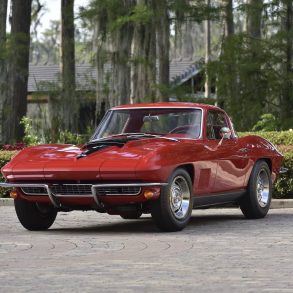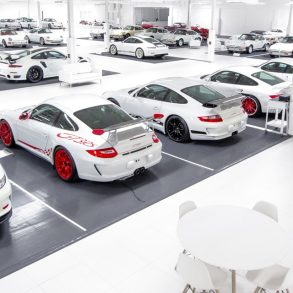
A Pontiac Catalina Lightweight and ‘S-Code’ Ford Mustang Boss 429 are among the headline offerings at the 13th annual Russo and Steele Scottsdale auction, scheduled for January 16-20, 2013 in Scottsdale, Arizona.
As one of the factory-built weapons conceived during the Super Stock wars of the early 1960s, Pontiac’s “Swiss Cheese” Catalina Lightweight was purpose-built just for one mission: to maintain dragstrip supremacy. To do this, 14 full-size Catalinas were plucked from the assembly line, stripped of all sound deadener and insulation, and relieved of one inside frame section. Aluminum body and mechanical parts were used extensively. Some 120 round lightening holes drilled into the sides of the frame rails at John DeLorean’s suggestion begat the famous “Swiss Cheese” moniker. As completed at the Pontiac assembly plant, the Super Duty 421-powered cars were some 800 pounds lighter and easily produced low-12s at about 115 mph on the quarter-mile. Just nine remain today.
The example that will be sold at the 2013 Russo and Steele Scottsdale auction event is one of the 14 original “Swiss Cheese” lightweights built by Pontiac and one of the 12 originally finished in Frost Silver. After being tested by Pontiac stalwart Arnie “The Farmer” Beswick, whom already had received his own car, this particular “Swiss Cheese” Catalina was instead delivered new to Wilmington, Delaware’s Union Park Pontiac.
During 1963, popular Union Park salesman and driver Harold Ramsey raced it to great effect against Mopar’s finest Super Stockers including Bobby Harrop’s “Flying Carpet” and Bud Faubel’s “The Honker”. Next, Ramsey altered the car’s wheelbase for A/FX, the forerunner to today’s Funny Cars. In May 1965, Ramsey ultimately achieved a low ET of 8.91 seconds at 148.00 mph with the Catalina, which continued racing into the late 1960s with Larry Johnson as the “Funny Tiger”.
The current owner acquired the big Cat, still wearing its late-‘60s livery, in 1997. Thorpe’s Body and Corvettes Shop of O’Fallon, Illinois executed a complete restoration with the 3,000 man-hour job returning the car to original appearance and specifications. In 2010, the restoration was completed and the Catalina achieved a perfect 400-point score that year at the June 2010 Charleston, West Virginia POCI Nationals, followed by Concours and Gold Certification at the November 2010 Corvette and Musclecar Nationals. During 2012, its winning streak continued with Senior Gold at the St. Charles, Illinois POCI Nationals and First Place at the Norwalk, Ohio Pontiac Nationals.
The 1963 Catalina Super Duty “Swiss Cheese” example offered at Russo and Steele Scottsdale is confirmed, documented, and pictured in the definitive book, Pontiac Musclecar Performance 1955-1979, by experts Pete McCarthy and John Angelis.

Created and released for just one purpose – to homologate Ford’s hot new Boss 429 engine for NASCAR Grand National competition – the “Boss Nine” was essentially hand-built by Ford subcontractor Kar Kraft of Brighton, Michigan.
Extensive modifications to the Mustang’s basic chassis were required to accommodate the big Boss, including the cutting and relocation of the front shock towers. A complete package, the Boss 429 included such special high-performance features as a stout “Toploader” close-ratio four-speed transmission, 9-inch Traction-Lok rear end, 3.91:1 gears, engine-oil cooler, trunk-mounted battery, competition suspension with front and rear anti-roll bars and staggered rear shocks, power front disc brakes, chrome Magnum 500 wheels, and fat F60 X 15 tires. Ford conservatively rated output of the “street” Boss 429 Mustang at 375 hp, a figure that hardly explained the car’s ability to cover the quarter-mile in the 12-second range with only a few minor modifications.
The most expensive Mustang of its era, the Boss 429 was predictably rare when new, with just 859 built for 1969 (including two Boss-Cougars). Of those, the first 279 cars of the series are even more desirable, with their special “S-Code” engines featuring heavy-duty NASCAR-spec connecting rods, beefy 1/2-inch rod bolts, and cross-drilled forged crankshafts. This example on offer at the 2013 Russo and Steele Arizona auction is one of the 279 original “S-Code” cars and bears Kar Kraft (KK) number 1431. Finished in Candy Apple Red, it was built on February 28, 1969 and shipped to Ed Schmid Ford in Ferndale, Michigan, just outside of Detroit. Sold on March 12, 1969, it found its way to Kentucky, where it spent most of its life.
As offered, KK 1431 is a correct rotisserie-restored, matching numbers car retaining the factory-original “S” engine, all of its “Boss 9” components, and the original body tag affixed to the radiator support. Everything works correctly and the car shows only 51,140 actual miles. Accompanied by restoration photos, the owner’s manual and miscellaneous Boss 429 marketing and advertising literature, it’s documented with the original build sheet, copies of Kar Kraft and Ford invoices and a list of all owners to verify its authenticity and history.
For more information, visit www.russoandsteele.com.
[Source: Russo and Steele]









